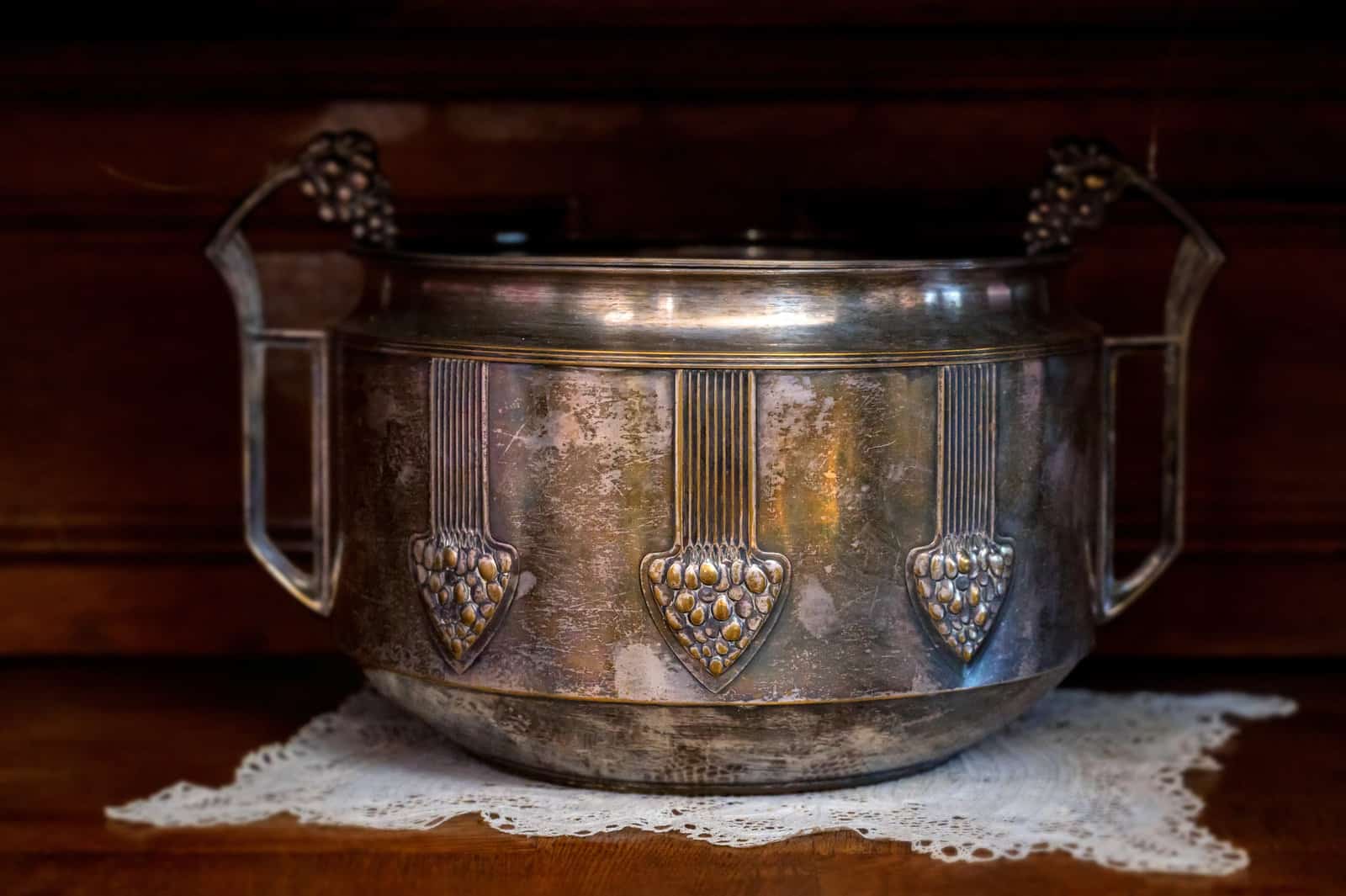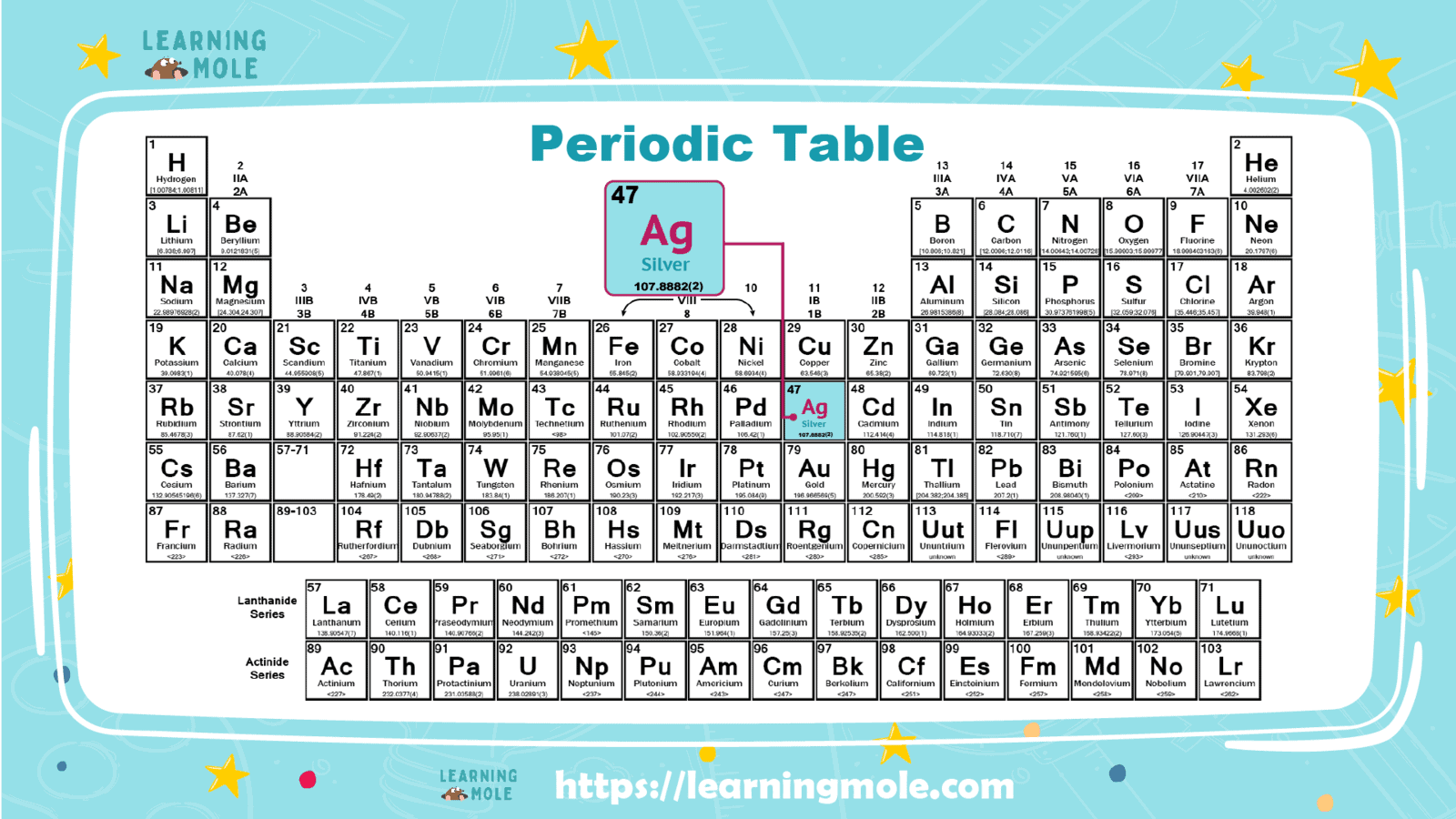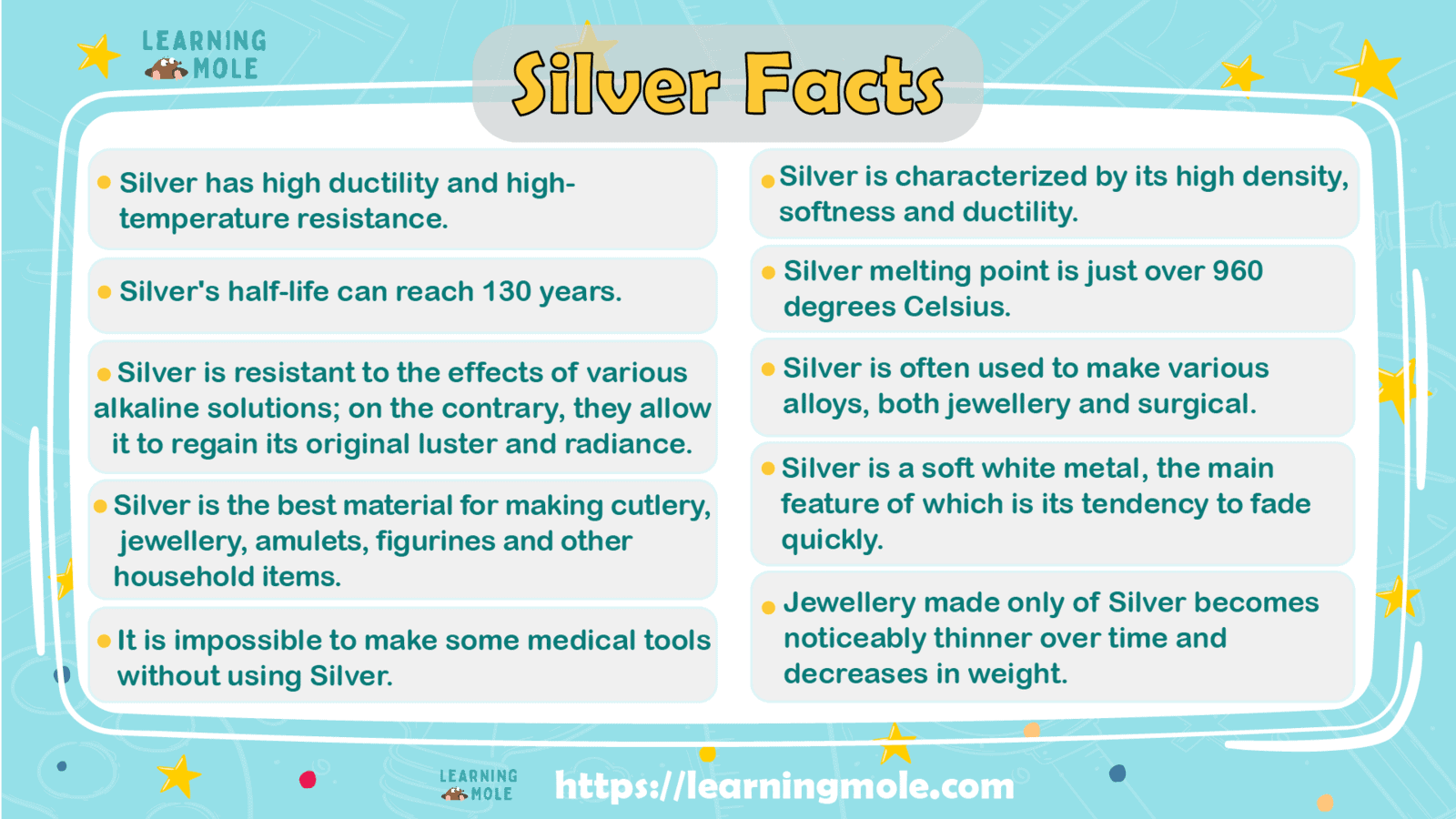
Silver:A Guide to the Special Element Silver for Kids
A metal of precious and valuable metals, it comes in second place after gold, and it is one of the chemical elements. It has its own chemical symbol, “Ag”, and it has a fixed atomic number equal to “47” it is considered one of the transition metals. It is located in the eleventh group and in the fifth cycle of the Periodic Table.
Silver is present in the rocks of the earth’s crust and on its surface in several forms. It may appear in the natural, free form or the form of an alloy with gold. This may appear in some metal components, as silver is a by-product of the refining and purification processes that occur to metals such as gold, copper and lead.
It is distinguished by its distinctive colour, which is between white and grey, and it is considered a precious metal or a money metal, which makes it used in the process of minting money.
It is considered one of the ancient metals. It has a greater chemical reactivity than gold, which makes finding it challenging most of the time, and it is more abundant than gold, but it is less abundant than copper, which makes it available in the form of small pieces or a thin plate, and it is possible. It is present in the form of dispersed chords and may be associated with a group of elements.
It takes many metallic forms, as it may be in the form of nectides or in the form of chalcogenides. Where these shapes are shiny and have an attractive appearance, and they are characterized by being semi-conductive, and they may be present in the form of sulfides, where they may be separate or accompanied by several elements such as lead found in the mineral galena.
It is purified during the electrolysis process that occurs for the associated metals; Where it is obtained as a by-product of great value, and silver is purified from the impurities inside it by treating it using expanded sulfuric acid, which is rich in oxygen.
Silver contains a number of isotopes that are produced in stars through the slow neutron capture process, in addition to being present in super colonies during the fast neutron capture process.

Chemical Properties
Silver is a metal that appears in the first section of the periodic table at position 47. Argentum is its alternate name (Argentum). According to chemistry, silver is more than just a metal; it is an element made up of two isotopes. This is exactly what explains these properties.
- High ductility and high-temperature resistance.
- Long half-life that can reach 130 years.
- Hydrogen sulfide has an effect. As a result, silver and many of its products often darken, but plaque can be easily removed from them.
- Argentum is resistant to the effects of various alkaline solutions; on the contrary, they allow it to regain its original luster and radiance.
The main compounds of this metal are responsible for the fact that silver does not react with oxygen and is destroyed by only four acids – sulfuric, hydrochloric, hydrobromic and nitric.
It is also important to understand that when silver comes into contact with sulfuric acid, it dissolves into an invisible precipitate, which distinguishes it from other noble metals. It is frequently used to separate argentum from gold.

Physical Properties
The most important physical properties of this white metal today are considered to be the following.
- Softness and ductility… These two indicators are closely related. Thanks to their tandem, silver is the best material for making cutlery, jewellery, amulets, figurines and other household items. It is also impossible to make some medical tools without using them.
- High density. This indicator puts silver and lead on the same level. There is simply no other precious metal with such a high value (10.5 units per cubic centimetre).
- Its melting point is just over 960 degrees Celsius… This figure for the precious metals category is very low.
- Compatible with other metals. This feature is closely related to the previous one. Therefore, silver is often used to make various alloys, both jewellery and surgical. He usually associates Argentum, copper, Argentum, steel, or even gold and silver. The properties of each alloy will be individual, depending on the proportions of each metal in it.
It is also important to know that silver is a soft white metal, the main feature of which is its tendency to fade quickly… At first glance, minor mechanical damage can leave a strong mark on it. Even jewellery made only of this metal becomes noticeably thinner over time and decreases in weight.

Silver History
Silver has a long history. The first evidence of silver mining dates back to 3000 BC, in Turkey and Greece, according to the Royal Society of Chemistry – RSC. Even the ancients knew how to polish silver. They heated silver ore and blew air on it, a process called cupellation. Although Silver does not react with air, but base metals such as copper oxidize and lead and separate from the precious metal.
It is formed from stellar explosions called supernovae, as is gold. The explosion of small stars produces silver, while larger stars produce gold, according to a 2012 study published in the journal Astronomy and Astrophysics.
It abounded in the land when Europeans arrived in the New World in 1492. The Spanish conquistadors discovered rich veins of silver and silver ore in South America and eagerly extracted this wealth. According to the Silver Institute, 85% of the silver produced globally came from From Mexico, Peru and Bolivia between 1500 and 1800.
Silver played a significant role in making the beginnings of photography possible. According to the Royal Society of Chemistry (RSC), silver nitrate was first used in clunky cameras’ photographic plates, which turn black as it reacted to light – and enabled photographers to instantly capture light. Even with the advent of digital cameras, silver remains a part of the traditional photographic process. According to data from 2003, each year, 1,920 cubic tons of silver were used for photographic purposes.
Electrical and electronic uses took the second place, with a consumption of 1230 cubic tons of silver for connections (wires) and equipment in 2003.
Jewellery, pure silver (silverware), and silver-plated objects and objects take third place with only 486 cubic tons. An additional 1,810 cubic tons go to various other uses.
Where does silver come from?
Although small amounts of silver are found throughout the world, deposits large enough for economic prospecting are found in only a few countries, with more than half of the global supply coming from just four countries (Mexico, Peru, China and Australia), and most of the silver coming from American (about two-thirds to three-quarters) from the western part of the country, specifically the states of Alaska (currently the leading silver-producing state in the United States), Nevada, Idaho, Montana and Arizona.
There are relatively few dedicated silver mines, and most silver (more than two-thirds of the global supply) is actually recovered as a by-product during mining for lead, zinc, copper, or gold. Silver is not recovered in its pure form but combined with other elements in ores (Ore minerals) such as argentite (silver sulfide), cerargyrite (silver chloride, also known as a silver horn), bergarjit (antimony silver sulfide, also called ruby silver), and sylvanite (silver gold telluride made of silver, gold, and tellurium), ores containing More than one helpful mineral in the name of polymetallic deposits.
Pure silver is recovered through a multi-stage process that varies according to the exact composition of the ore. Typically the ore is crushed, smelted (air-heated) in a furnace, and chemically treated in some way (perhaps reacting with an acid to dissolve the silver or mercury, which removes the silver by forming an alloy called an amalgam). ), then it is purified by electrolysis (a process in which electricity is passed through a solution to separate it into its components).

How to extract silver?
In the beginning, the main silver ores are crushed until a mixture of a group of basic metals such as copper and lead is formed, and then the silver is separated from the associated metals in it while carrying out the copper purification process, and this process is called sludge.
After the completion of this sludge process, the process of purifying and extracting silver from metallic lead ores begins in a way called the Parkes method, which is a method in which zinc is added to molten lead to form a solid alloy of silver.
After the silver ingot is formed, it will float to the surface, after which the zinc ingot is heated until it is separated from the silver. In order for silver to be extracted in a manner devoid of its association with other metals, and upon completion of the separation of the silver metal, the electrolysis process begins, which works to filter and purify the extracted silver.

Applications and Uses
The reason behind our use of any substance always lies in its physical and chemical properties and looking at what is remarkable, helpful, or unusual about a substance always helps us understand why people used it in the past (or how they will use it in the future), and this is the basic idea behind science Materials.
The thing we first think of is silver (its attractive shiny surface), and it explains why it is so widely used in coins, cutlery, and jewellery. The luster makes silver an ideal material for scientifically accurate mirrors (a highly polished piece of silver that reflects about 95 percent of the light that falls on it).
Although the use of silver meant the widespread use of aluminium and rhodium instead, still in the world of optics silver compounds have been used since the 19th century as a basis for photography, and silver halide salts (such as silver chloride, silver iodide and silver bromide) are becoming darker. When light falls on it, this simple scientific phenomenon was the basis for taking pictures until digital cameras appeared in the late twentieth century.
Since silver is a good conductor of electricity, it is not surprising to find that it is widely used in electrical and electronic equipment (including batteries) and as a component of some types of solder. Its lack of a chemical reaction makes silver very suitable as a lining for industrial tanks and containers. It is also used as a catalyst. Important (reactions accelerator) in the production of many organic (carbon-based) chemicals.
Being non-reactive, silver and its compounds find important uses in wound care dressings, and also in medicine.
Various silver compounds (including silver nitrate) act as powerful antiseptics and antibacterial agents although silver has been primarily replaced in joint replacement by titanium. It is stronger and lighter, and silver is used in many other diverse applications, such as tinted glass, thermal car windows, water filters, and miniature antennas that are used in radio frequency identification devices.
PHOTOGRAPHY:
When a silver halide, a chemical compound made up of silver plus a halogen, is subjected to the action of light, the absorbed radiation gives it the energy needed to break the bond between the halogen and the metal.
The silver deposit thus formed is the more dense, the greater the intensity of the illumination and it is, therefore, possible to obtain a negative image of the subject framed in a darkroom.
This direct blackening of the halide, known as the print-out effect, was the first method used to obtain images at the dawn of photography, but it had the drawback of requiring very long exposure times. From the earliest days of photography, however, it was discovered by chance that it was not necessary to wait for the formation of a visible image on the sensitive material: even after a short exposure, it was possible, with an appropriate chemical treatment, to obtain a perfectly formed image.
PHARMA:
Colloidal silver is a universal remedy with almost no side effects for the treatment of numerous diseases. It has been shown to act against bacteria (for example, staphylococci and streptococci), viruses and fungi (for example, saccharomycete Candida albicans). It only takes a few minutes for him to kill all these pathogens.
The interesting thing is that usually, the bacteria “useful” to the human body present in the large intestine are spared, since the colloidal silver is reabsorbed at the latest in the small intestine by blood or lymphatic route. However, in some cases, it is desirable that colloidal silver acts in the large intestine.
Colloidal silver can also be used in diseases whose causes are unknown or not fully understood. In the meantime, its excellent effects have been described in relation to several hundred clinical pictures, with an enormous spectrum of action.
After a long break during which interest in silver and colloidal silver had greatly diminished, research in this field has become very active again for some years. Science has resumed dealing with the therapeutic properties of this metal in the most various sectors, also confirming the results and experiences of the past with new methods.
The use of colloidal silver has been tested in various diseases, including numerous disorders of the eyes, respiratory tract, skin, locomotor system and nervous system. If you think that a broad-spectrum antibiotic (drug against bacterial infections) or an antifungal (drug against mycoses) is always able to kill only a part of the pathogens and can easily give rise to resistance, the use of silver represents a huge advantage.
An antibiotic only works against a small number of different pathogens and never against viruses. Furthermore, colloidal silver is practically free of side effects, while chemicals can have many and even serious ones.
Colloidal silver can be used in therapy but also in disease prevention, as it supports and relieves the immune system.
At the basis of the recently rediscovered principle of dressing wounds with compresses or silver patches is the same principle on which dressing with colloidal silver is based. In addition to silver sulfadiazine, which was introduced in 1968, today, mainly compresses and dressings that release silver ions are used.
In addition to having an anti-inflammatory action, silver ions promote the formation of new epithelial tissue and accelerate healing. In the initial stage of healing, wounded tissue absorbs more silver than in later stages, probably because healthy tissue (epithelium) forms a partial barrier to silver. Its action here is, therefore, double since the protection against infections after a burn is of the utmost importance. Colloidal silver probably facilitates the production of undifferentiated cells intended to replace aged or damaged ones. It is likely that this occurs due to a positive influence exerted by silver ions on programmed cell death (apoptosis).
In experimental studies, it was found that silver also stimulates the formation of particular proteins, the so-called metallothioneins, in epithelial cells. These proteins are used to detoxify the body from heavy metals such as cadmium and mercury and promote healing.
Benefits of silver for the body
Anti-microbial: silver ions interfere with bacterial cell walls; to disrupt all microbial processes and rid the body of a large part of toxins, in addition to using them in the metabolism process.
Burn treatment: Silver is used in the manufacture of vital anti-burn creams, and it is also used in many bandages to treat skin ulcers.
Colloidal silver: is used to cleanse the intestines, boost the immune system, and treat infections. Colloidal silver can be defined as a solution consisting of small particles of silver suspended in a liquid that is evenly distributed within these particles.
- Intervention in the treatment of severe constipation and diarrhea.
- It interferes with the treatment of irritable bowel diseases. This is done by using customized capsules.
- It interferes with controlling the sugar level in the man’s feet.
- It has the ability to treat a large number of traditional diseases, such as treating fever and chronic intestinal infections.
- It works to discharge excess charges, especially in the man’s body; This is because they are conductive to electricity.
Can Silver hurt?
But, despite all the beneficial properties, silver taken in large doses, like many other medicines, becomes poison.
People who work with silver and its salts for a long time can cause great harm to their health.
- Serious burns of the mucous membrane of the respiratory tract and stomach… Caustic fumes of salt in high concentrations are extremely dangerous. In such cases, only hospital intensive care will help.
- Argyria: it is a disease in which the body does not produce melanin, and silver fumes colour the skin grey, green, or even purple. The worst thing is that it is impossible to heal, as well as return the skin to its former appearance. In this case, the patient himself may not experience any unpleasant sensations.
There is a plus – a high concentration of silver in the body protects a person from any viral infection.
Related Articles:
- Platinum: All you need to know about the Strong element
- Mercury: Many debates about the valuable Element
- Zinc: Chemical Element Properties, Formation and Uses
Why not subscribe to our LearningMole Library for as little as £1.99 per month to access over 1200 fun educational videos.


Leave a Reply